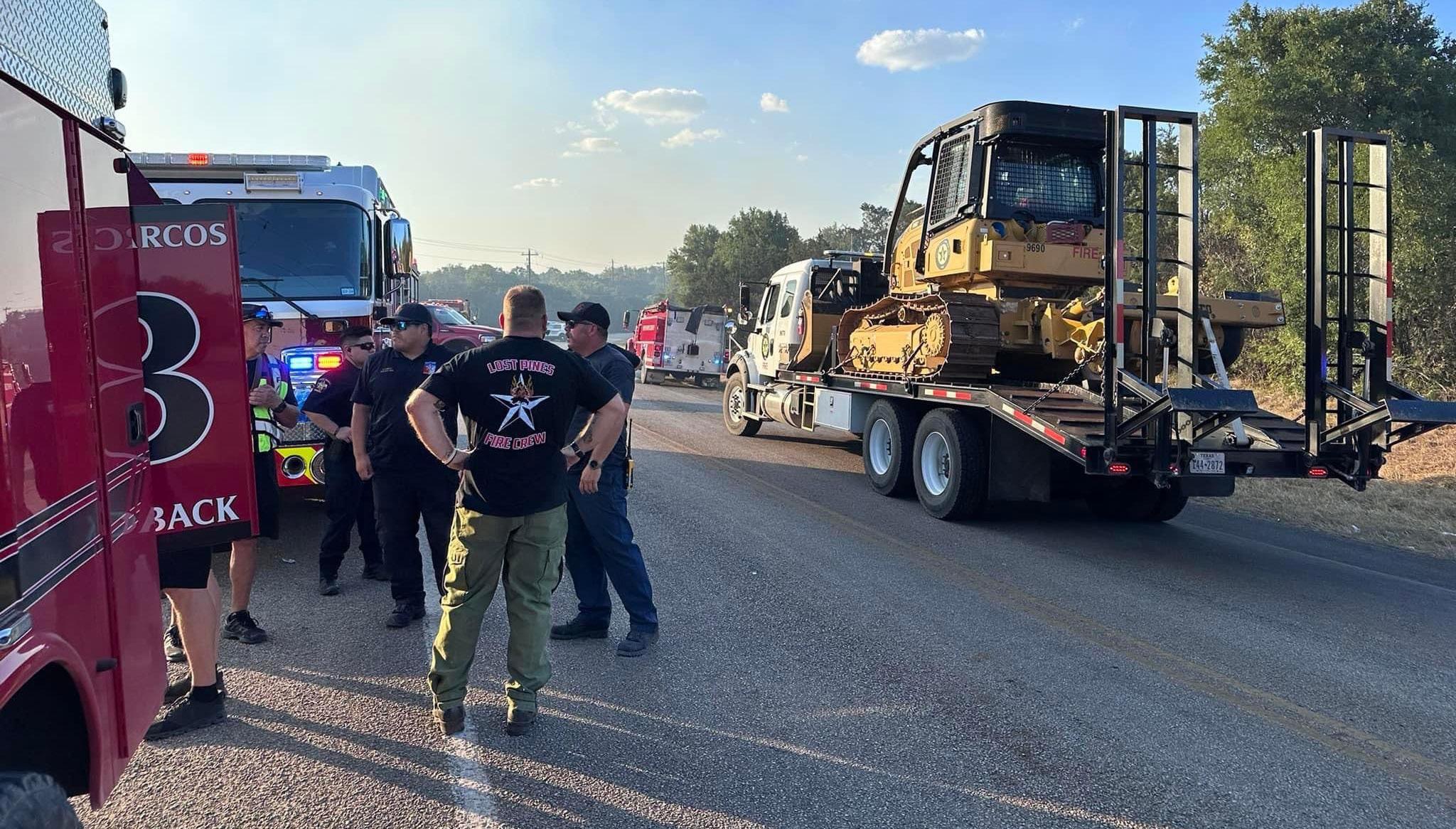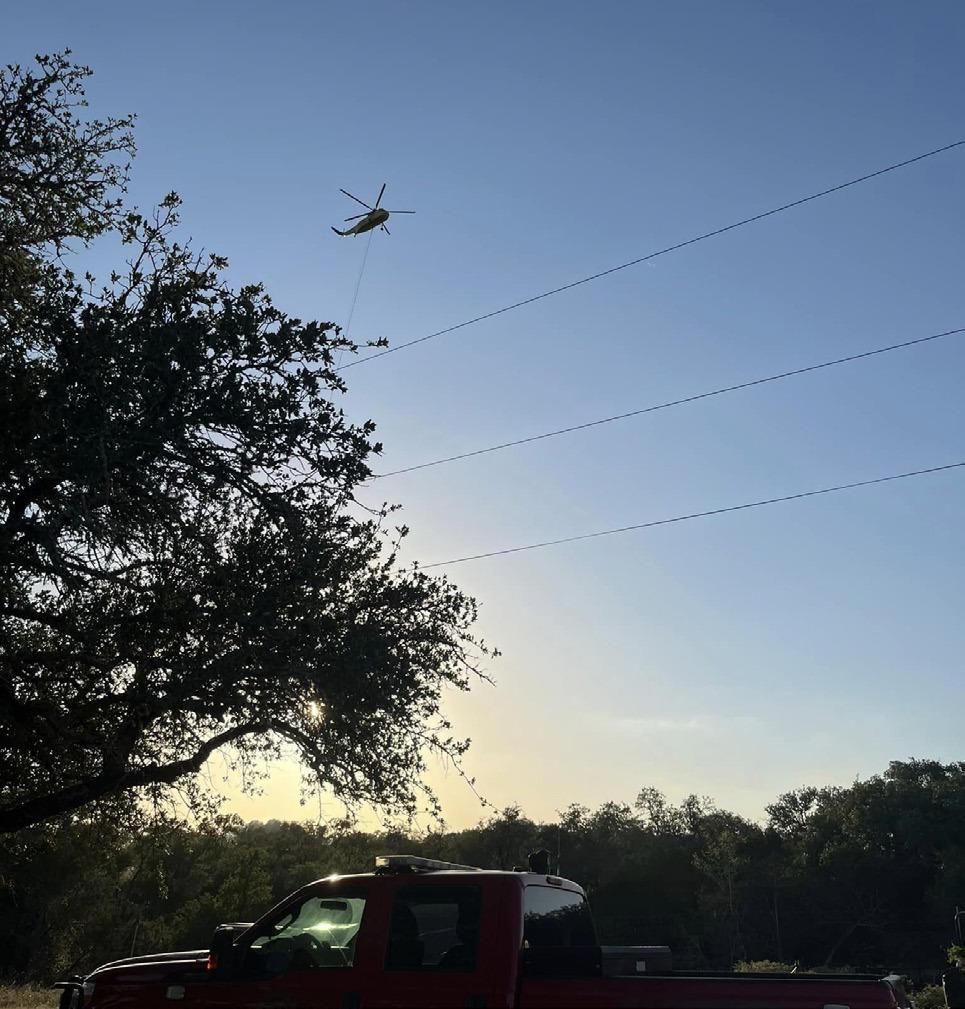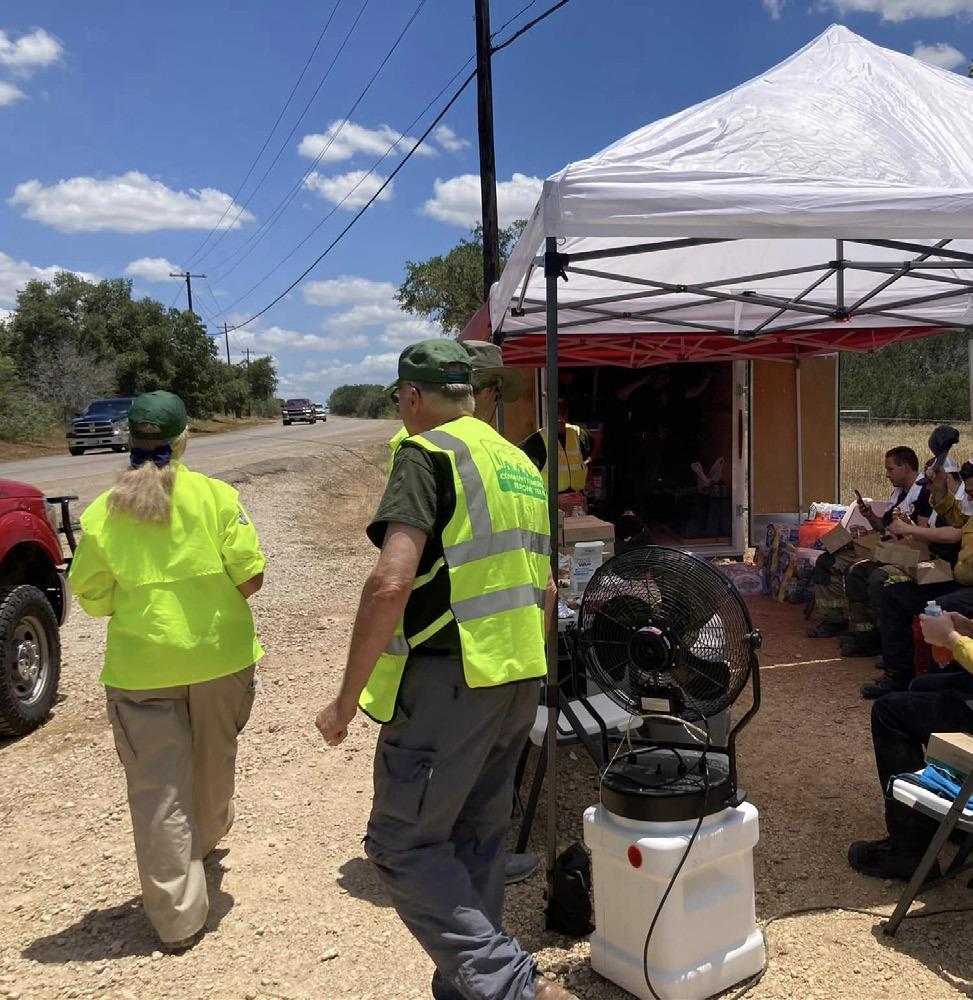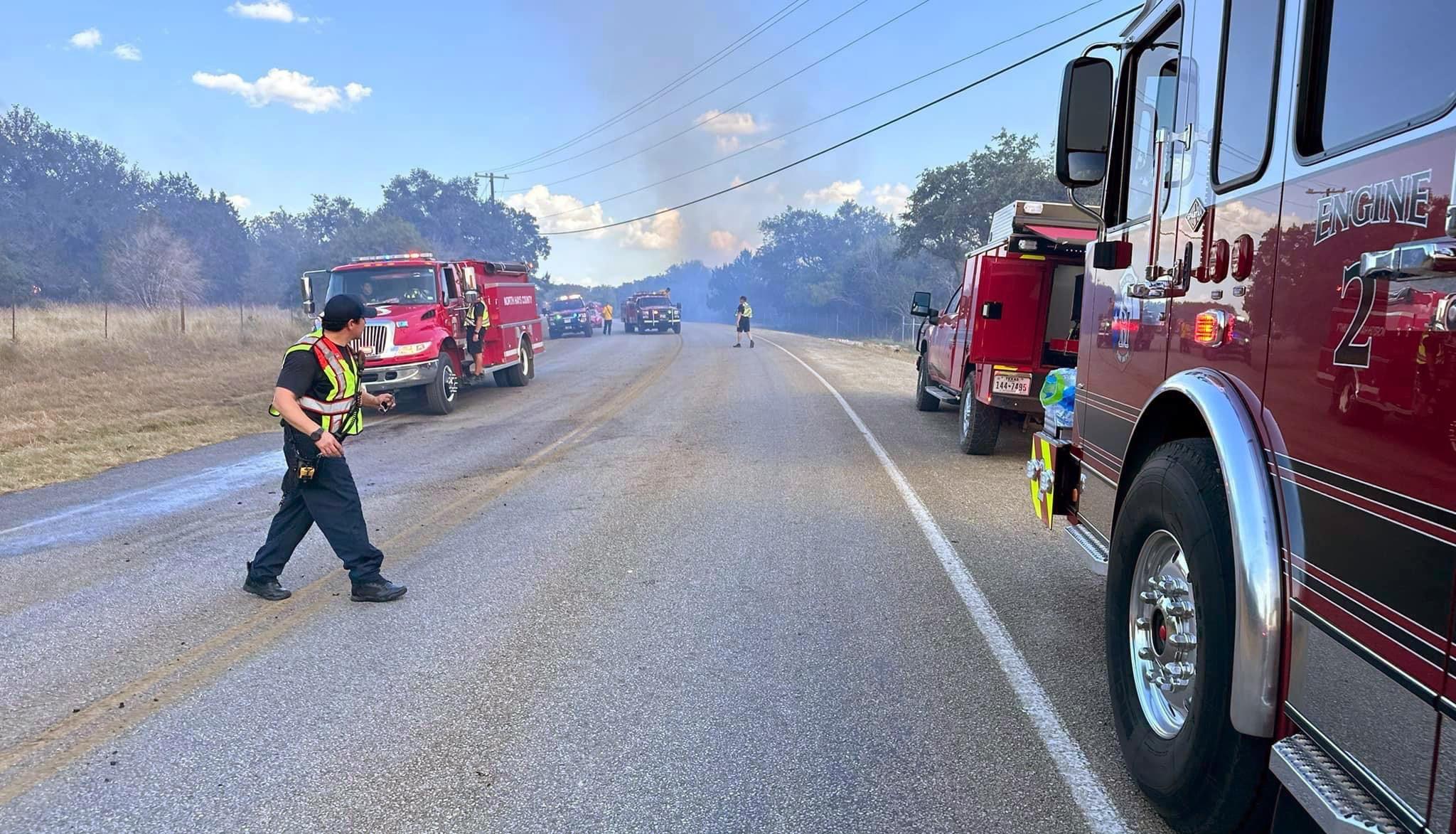


Pictured are the responses by area fire departments, Hays County Emergency Management and other agencies called to the scene of a wildfire this past weekend.
Photos provided by Hays County EMS and Commissioners Court Judge Ruben Becerra

Firefighters work to bring wildfire under control in Hays County this past weekend.
Photo provided by Hays County Judge Ruben Becerra
Wildfire brought under control, as conditions worsen
This past weekend in San Marcos, a wildfire off of Hilliard Road burned an area of approximately 50 acres. There were no structural losses or loss of life reported, but the wildfire is just one indication of an environment under stress by weeks of excessive heat.
According to Hays County Emergency Management officials, the Vineyard Hill fire started on Saturday with a burn pit that was not properly contained. Responding agencies were Emergency Service District 3, ESD 4, ESD 5, ESD 6, ESD 8, the York Creek Fire Department, the city of San Marcos Fire, Department, San Marcos Hays County Emergency Management Services, Star Flight, the Texas Forest Service, the Hays County Sheriff's Office, the Hays County Community Emergency Response Team and the Office of Emergency Services and Transportation.
CERT and COSM demobilized Sunday, and all ESD’s demobilized at 6 a.m. Monday, officials stated.
Hays County Fire Marshal Mark Wobus said there are multiple causes for fires of this type and he offered advice as to the kinds of activities to avoid to quell the start and spread of fires.
Wobus said Hays County is unique when it comes to the impacts of drought and fire safety because it is divided by Interstate 35 which is also the dividing line between fuel types and soil makeup. This can lead to differing levels of dryness on either side.
Wobus said he uses the Keetch-Byram Drought Index to measure soil moisture across different areas in the county. He said when looking at the different sides, it is necessary to take the average of the two measures. “As of today [Friday] our [Hays County] low side is 385 and our high side is 512, with the median being 440,” Wobus said “All three of those numbers will change on a daily basis, dependent upon how much rainfall we get, cloud cover, heat–how hot it is, [and] how windy it is.”
The drought index ranges from 0 to 800, where a drought index of 0 represents no moisture depletion and an index of 800 represents absolutely dry conditions.
According to the Texas Interagency Coordination Center website, dead fuel moisture is critical to determining what constitutes fire potential. This data responds solely to ambient environmental conditions. For example, fuels in the national fire danger rating system have four categories and are defined as the time it takes a fuel particle to reach 2/3s of the way to equilibrium within its local environment. The fuel categories are based on time and include: one hour–less than 1/4 inch in diameter; 10-hour–1/4 to one inch in diameter; 100hour–one to three inches in diameter; and 1000hour fuel–three to eight inches in diameter.
“One hour [fuel] … is about the size of a pencil and smaller, and that’s what we refer to as a fine, flashy fuel. Those are your grasses, your twigs, your leaves, your stalkier grasses like Johnson Grass. What it refers to is in that one hour time frame that fuel can go from non-receptive to receptive, so essentially [it goes from] unable to burn to able to burn. So, wet to dry,” Wobus said. “The sizes refer to both live and dead fuel moisture, so ten hour fuels are holding right now because we’ve had so much moisture. When we talk about night-time recovery - relative humidity comes back up so that allows those larger fuels to cool down and take in moisture from the atmosphere to essentially recharge. Then they start all over the next day. The sun comes up, they start drying back out again … even if fuel is dead, it still gains and loses moisture from the atmosphere whether it’s relative humidity or rainfall.”
Wobus said currently there is a drying trend because it's summertime, and that the numbers are average for this time of year.
“We had quite a bit of rainfall in the spring, and that allowed a lot of fuel to grow,” Wobus said. “A lot of it has now started to turn brown over these last several weeks, because of the heat, because of the dry wind [and] because of the lower relative overall humidity. So, it has really been pulling the moisture out of this stuff.”
He noted the longer we go without significant rainfall and the longer the fuels stay unmanaged, the higher the potential for fire.
“All it takes is that one spark in the right fuel bed, that’s in the wrong area, and you have a disaster,” Wobus said.
He said the freezes that we saw in the winter have added more fuel that could potentially ignite.
“We had those trees that were damaged - either the limbs broke out of the trees or the entire tree died - from the frost, and now that just adds potential fuel to the fire,” Wobus said. “The grasses carry the fire to the bigger fuels. The bigger fuels can then create the control problems and require more water to put them out and/or if they’re close to the control line maybe that spark that then gets it across the control line to keep the fire moving later into the day and the next day.”
He said the drier areas in the county were Buda going toward Niederwald, but Bexar Creek just below the Travis County line is the area with the most soil moisture. San Marcos had an index between those two as of Friday.
Wobus has recommendations for times to do certain high risk activities.
“If they’re going to mow or if they’re going to shred - try to do it in the morning hours when the winds are less and the temp is less and the relative humidity is a lot higher. Avoid cutting, grinding, [and] welding in the afternoon hours,” he said. “Everything that can burn will burn or is able to burn requires a certain amount of heat placed to it in order for it to ignite and burn. If we’re at 104 degrees at 2 o'clock in the afternoon, that’s our ambient temperature of 102. So, if you have the radiant heat from the sun that comes down through the atmosphere and it's at 104, 105 degrees then it bounces back off of the surface of the earth … In that surface area we now have the reflective heat that heats up fuel … it brings it that much closer to the heat that is required to ignite it.”
He added that the fuel bed temperature with that combination of heat sources could be 120 degrees, and if it ignites at 150 degrees would only take a small spark to catch on fire.
Wobus said small occurrences have the potential to start a fire.
“A farmer running an electric fence … if the grass grows up through that electric fence or into that electric fence and gets in contact with it, it can start a fire,” he said.
Wobus said be cautious when conducting an activity involving fire or small sparks.
“If you are going to be out welding, cutting and grinding, and it has to be done later in the afternoon, take the time to wet down your work area. Have somebody there as a spotter to watch, and if there is a fire, stop what you are doing and get the fire under control. Having something available–a water hose, a bucket of water, a fire extinguisher–that you can utilize to try and put it out. Don’t try and fight the fire for 20 or 30 minutes and then call for help,” he said.
He notes that it is important to call 911 before trying to manage the fire.
Wobus said that a burn ban is one tool to help mitigate the likelihood of a wildfire but does not rule it out. He said the burn ban should be a reminder that officials believe there is the potential for a wildfire to occur. Wobus said he has worked in fire service for 37 years, and he’s seen crazy things that have started a fire - the burn ban just removes one of those factors but many others remain.
“By putting in a burn ban, we are just taking that one item away from the potential list of how a fire could get started,” Wobus said. “We’re still going to have the family that’s going on vacation, dragging their RV trailer or their boat trailer down the road and it blows a tire and the hot rubber gets in the grass and starts a fire. Or, a bearing locks up in the hub, and it throws the hot bearings into the grass which starts a fire. Or, a bird landing on top of a transformer that shorts out on top of the terminals and falls to the ground and starts a fire. Or, somebody working in their field and trying to start a tractor with jumper cables and the sparks from that are enough to start a fire.”











